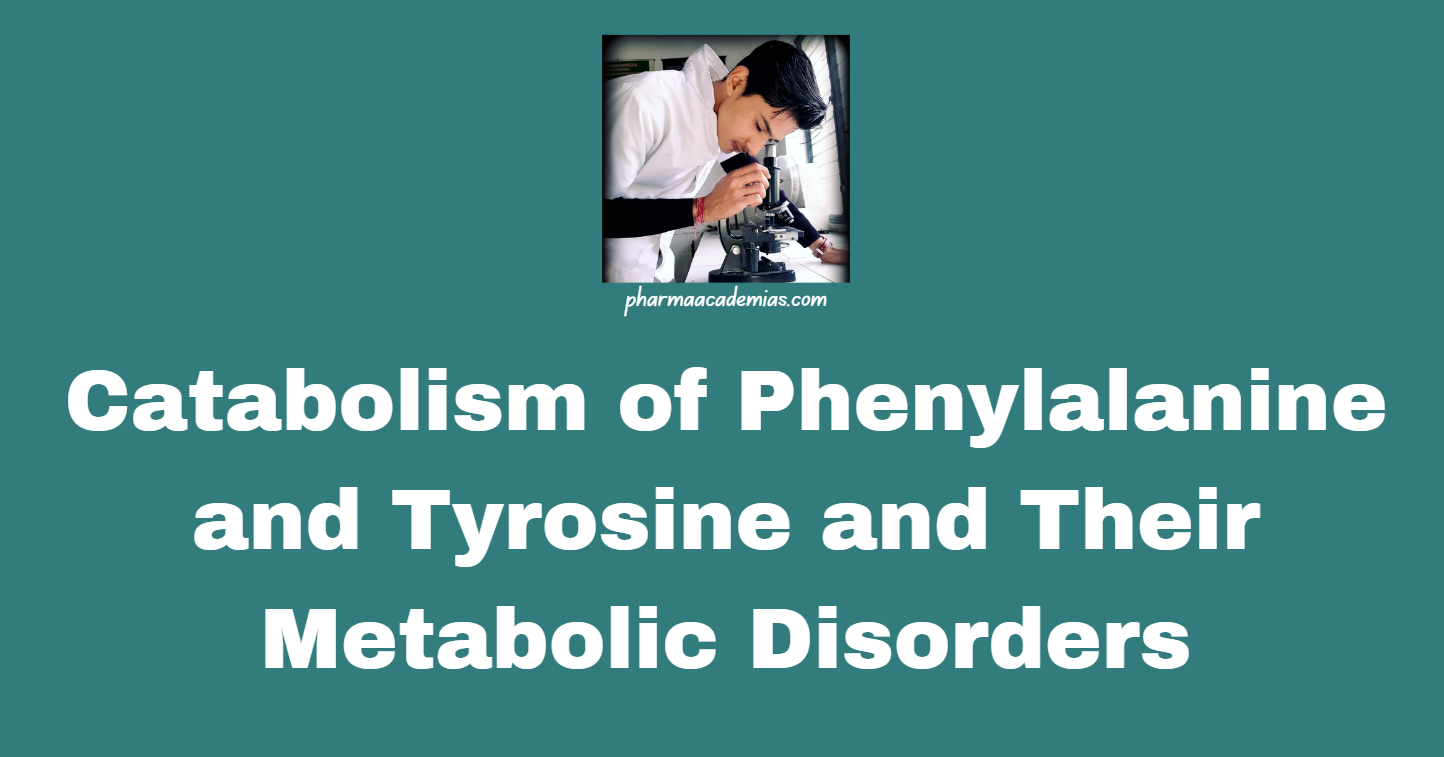Phenylalanine and tyrosine are essential amino acids involved in the synthesis of proteins and important biomolecules such as neurotransmitters, hormones, and pigments. Their catabolism is tightly regulated, and disruptions in these pathways can lead to serious metabolic disorders. This note provides a detailed overview of the catabolism of phenylalanine and tyrosine, followed by a discussion of the associated metabolic disorders: Phenylketonuria (PKU), Albinism, Alkaptonuria, and Tyrosinemia.
Catabolism of Phenylalanine and Tyrosine
Phenylalanine Catabolism
Phenylalanine is primarily catabolized to tyrosine through a hydroxylation reaction:
1. Conversion of Phenylalanine to Tyrosine:
Enzyme: Phenylalanine hydroxylase (PAH)
Cofactor: Tetrahydrobiopterin (BH4)
Reaction:
Phenylalanine + BH4 + O2 → Tyrosine + BH2 + H2O
Tyrosine Catabolism
Tyrosine is further degraded through several steps to ultimately form fumarate and acetoacetate, which enter the citric acid cycle (TCA cycle) and are used in energy production:
1. Conversion of Tyrosine to p-Hydroxyphenylpyruvate:
Enzyme: Tyrosine aminotransferase (TAT)
Reaction:
Tyrosine + α-Ketoglutarate → p-Hydroxyphenylpyruvate + Glutamate
2. Conversion of p-Hydroxyphenylpyruvate to Homogentisate:
Enzyme: p-Hydroxyphenylpyruvate dioxygenase (HPD)
Reaction:
p-Hydroxyphenylpyruvate + O2 → Homogentisate
3. Conversion of Homogentisate to Maleylacetoacetate:
Enzyme: Homogentisate 1,2-dioxygenase (HGD)
Reaction:
Homogentisate + O2 → Maleylacetoacetate
4. Conversion of Maleylacetoacetate to Fumarylacetoacetate:
Enzyme: Maleylacetoacetate isomerase (MAI)
Reaction:
Maleylacetoacetate → Fumarylacetoacetate
5. Conversion of Fumarylacetoacetate to Fumarate and Acetoacetate:
Enzyme: Fumarylacetoacetate hydrolase (FAH)
Reaction:
Fumarylacetoacetate + H2O → Fumarate + Acetoacetate
Metabolic Disorders Associated with Phenylalanine and Tyrosine Catabolism
1. Phenylketonuria (PKU)
Cause: PKU is caused by a deficiency in phenylalanine hydroxylase (PAH), leading to an inability to convert phenylalanine to tyrosine. As a result, phenylalanine accumulates in the blood and tissues.
Genetics:
Inheritance: Autosomal recessive
Gene: Mutations in the PAH gene
Symptoms:
– Intellectual disability
– Seizures
– Behavioral problems
– Musty odor of the urine
– Eczema
Diagnosis: Newborn screening through blood tests measuring phenylalanine levels
Treatment:
Dietary Management: A low-phenylalanine diet, supplemented with a phenylalanine-free medical formula
Sapropterin (BH4): Some patients respond to sapropterin, which enhances PAH activity
2. Albinism
Cause: Albinism results from defects in the production of melanin, the pigment responsible for skin, hair, and eye color. This is often due to a deficiency in tyrosinase, an enzyme crucial for melanin synthesis from tyrosine.
Genetics:
Inheritance: Autosomal recessive (most types)
Gene: Mutations in various genes, including TYR (tyrosinase gene)
Symptoms:
– Hypopigmentation of the skin, hair, and eyes
– Vision problems, including nystagmus and photophobia
– Increased risk of skin cancer
Diagnosis:
– Clinical examination
– Genetic testing
Treatment:
– No cure
– Management focuses on vision care and protecting skin from UV radiation
3. Alkaptonuria
Cause: Alkaptonuria is caused by a deficiency in homogentisate 1,2-dioxygenase (HGD), leading to the accumulation of homogentisic acid, which deposits in connective tissues and is excreted in urine.
Genetics:
Inheritance: Autosomal recessive
Gene: Mutations in the HGD gene
Symptoms:
– Darkening of urine on standing
– Ochronosis (bluish-black discoloration of connective tissues)
– Arthritis, especially in the spine and large joints
Diagnosis:
– Detection of homogentisic acid in urine
– Genetic testing
Treatment:
– No definitive cure
– Symptomatic management of arthritis
– Dietary restriction of phenylalanine and tyrosine
4. Tyrosinemia
Tyrosinemia refers to a group of disorders characterized by defects in tyrosine catabolism, leading to the accumulation of tyrosine and its metabolites.
Types of Tyrosinemia:
a. Tyrosinemia Type I (Hepatorenal Tyrosinemia):
– Cause: Deficiency in fumarylacetoacetate hydrolase (FAH)
– Genetics: Autosomal recessive
– Symptoms: Liver failure, renal dysfunction, rickets, and high risk of hepatocellular carcinoma
– Diagnosis: Elevated levels of succinylacetone in blood and urine
– Treatment: Nitisinone (NTBC) to block upstream tyrosine catabolism, dietary restriction of tyrosine and phenylalanine, liver transplantation in severe cases
b. Tyrosinemia Type II (Oculocutaneous Tyrosinemia):
– Cause: Deficiency in tyrosine aminotransferase (TAT)
– Genetics: Autosomal recessive
– Symptoms: Eye pain, photophobia, skin lesions on palms and soles, intellectual disability
– Diagnosis: Elevated tyrosine levels in blood
– Treatment: Dietary restriction of tyrosine and phenylalanine
c. Tyrosinemia Type III:
– Cause: Deficiency in 4-hydroxyphenylpyruvate dioxygenase (HPD)
– Genetics: Autosomal recessive
– Symptoms: Intellectual disability, seizures, intermittent ataxia
– Diagnosis: Elevated levels of 4-hydroxyphenylpyruvate and related metabolites in blood and urine
– Treatment: Dietary restriction of tyrosine and phenylalanine
Summary
Phenylalanine and tyrosine catabolism involves a series of enzymatic steps that convert these amino acids into intermediate metabolites that enter the citric acid cycle. Disorders in these pathways, such as Phenylketonuria (PKU), Albinism, Alkaptonuria, and Tyrosinemia, result from specific enzyme deficiencies and lead to a range of clinical manifestations. Early diagnosis and appropriate management, including dietary modifications and specific treatments, are crucial for improving outcomes and quality of life for individuals affected by these metabolic disorders.

